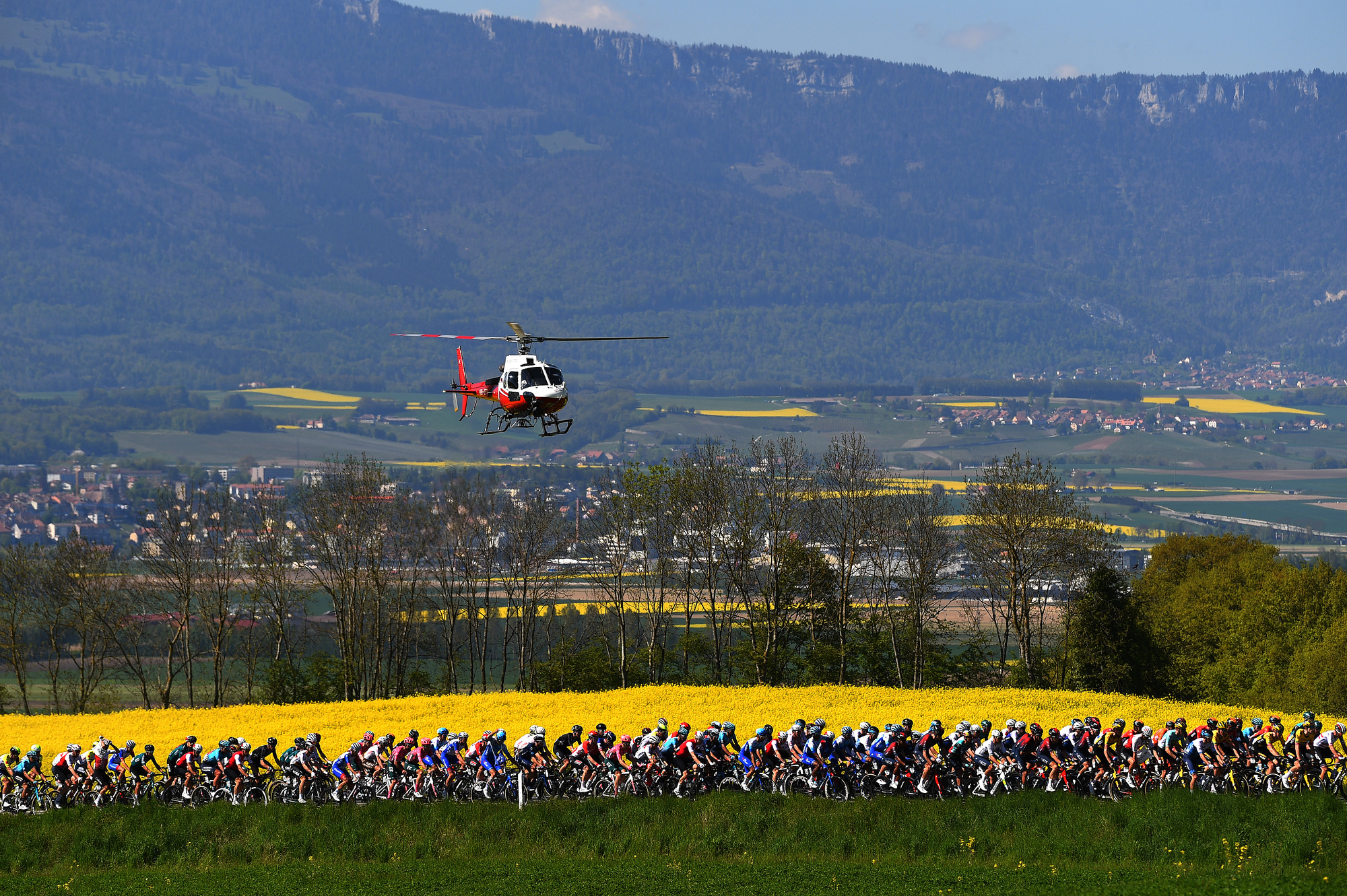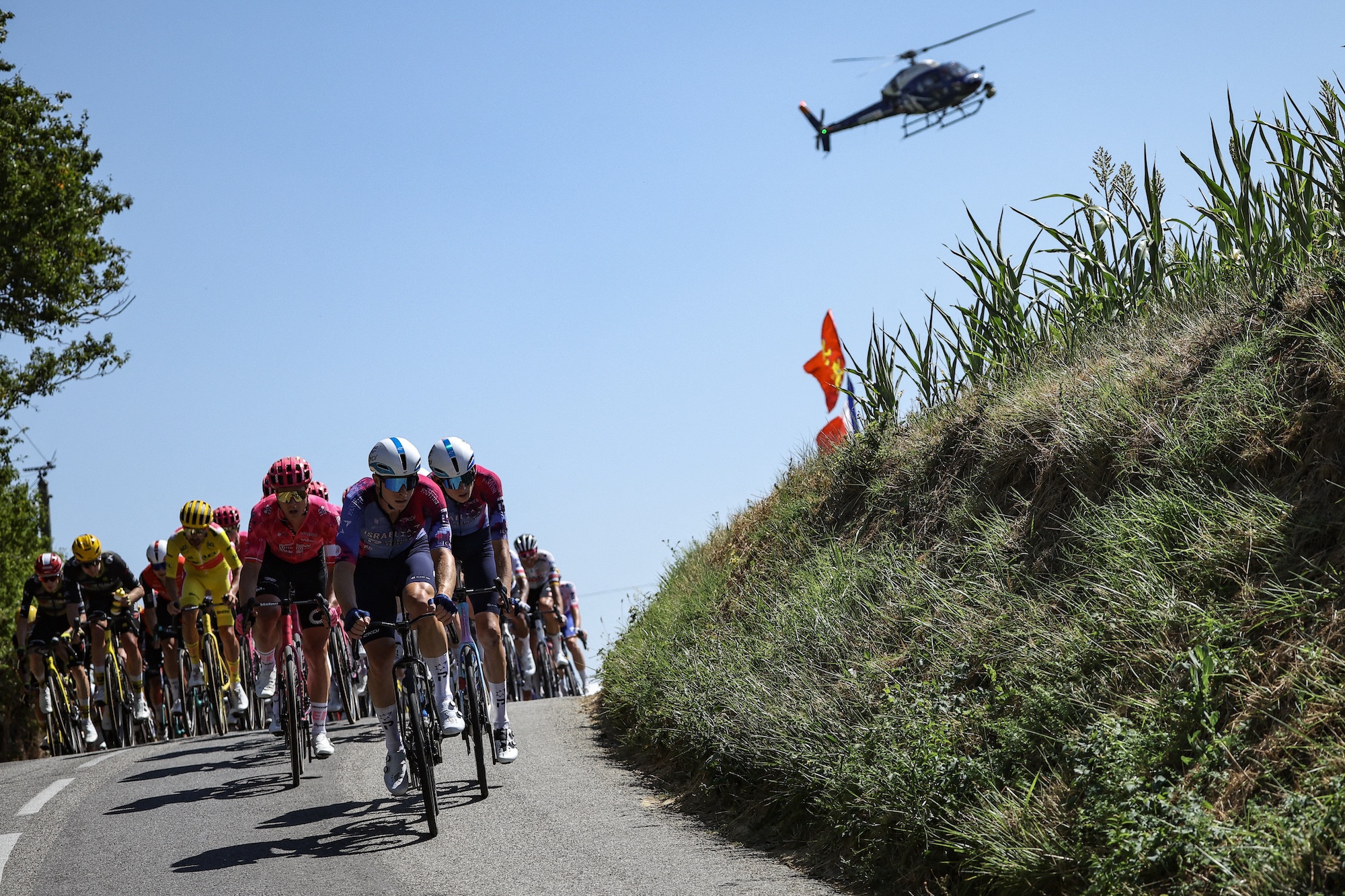Why camera drones are a long way off replacing helicopters at the Tour de France
A transition from multiple helicopters in the sky to drones will not take place anytime soon - even with 5G networks helping the cause


As the Tour de France, and bicycle racing in general slowly begins its drive to become greener and more sustainable, the question on many people’s lips is: why can’t drones replace helicopters in providing the television footage?
It’s what we at Cycling Weekly have assumed for a while, too. We wrote in our eight environmental proposals in August that race organisers should down the choppers and embrace the modern technology of drones.
That solution, however, is not quite so simple.
Moreover, it’s a very long way off from even being possible, due to technological and regulatory limitations, as well as the slow rollout of the 5G networks. As Will Glover, a drone pilot for Flying Pictures, explains to CW: “It’s highly unlikely we’ll see changes in the way live aerial coverage is captured during cycling races in the next four or five years.”
The main issue preventing extensive drone coverage is the battery life and efficiency of the technology. “It’s one of the biggest challenges,” Glover says. “Our average drone flight time with a heavy lift system, capable of a quality live broadcast, is around 20 minutes which varies depending on different environmental conditions such as altitude, temperature and operating style.
“To give an example, drones have to work harder at altitude, such as in the Alps, and in the winter the batteries don’t work as well. 20 minutes isn’t nearly enough for a bike race.
“There are other options which give longer flight times such as hydrogen-powered drones that we have been actively exploring, but even with longer flight times, regulatory issues present themselves.”
The latest race content, interviews, features, reviews and expert buying guides, direct to your inbox!
As Glover alludes to, the other obstacle drone pilots run into is the myriad of regulatory rules, an issue that becomes even more complex when covering cycling. “Most drone exercises are called visual line of sight operations, which means the pilot has to see the drone at all times,” Glover explains. “With more risk mitigation, you can conduct extended visual line of sight operations which allows the pilot to control the drone using aids to remain safe, such as a spotter with binoculars.
“That’s very difficult in a bike race because of the great distance, because of trees, tunnels and mountains which mean you lose line of sight and thus the drone pilot cannot control the drone, risking the safety of the flight.
“The only way of doing it would be to have various drone pilots along the course, such as at King of the Mountain and intermediate sprint locations, but that still wouldn’t cover the full race. A helicopter, its pilot and camera operator costs around £7,000 a day - each drone team costs you around £3,000. So if you have three drone teams it’s not cost effective and you still can’t broadcast the whole race.”
That’s not all. “The second regulatory problem is the minimum distances drones are required to be away from uninvolved people and property,” continues Glover. “I’ve gone to multiple Tours de France and experienced the thousands of people watching the race. Drones don’t undergo the same scrutiny and airworthiness certification as manned aviation does, and as such flying drones over crowds is a very large safety risk and wouldn’t be allowed by any Civil Aviation Authorities.
“There are things we can do to make drones safer and in some cases we are able to operate in congested cities, 10 metres from people. But we have to do a lot of things to comply with that, like having parachutes fitted on the drones, completing an in-depth risk assessment, and having a second drone pilot available if the main pilot becomes incapacitated.”
All this explains why Glover is sceptical that cycling can make the transition from helicopters to drones. “Regulation and technology needs to change significantly before drones can be used in a way that wouldn’t drastically compromise the fantastic race coverage we’ve all been used to. There is not just one issue to overcome but multiple.”
So what, then, is the solution to making broadcasting more sustainable? “Flying Pictures did an extensive sustainability report recently on all the different options. The result was that running a helicopter on sustainable aviation fuel (SAF) is by far the best option.
“SAF fuel is three or four times more expensive than normal aviation fuel, but if there’s a compromise to be made in any way to improve sustainability of sporting events which cover great distances like cycling, then flying a helicopter with SAF is definitely the best way at present.”

FranceTV often have half-a-dozen broadcast helicopters in the sky at any one time during the Tour de France
However, it’s not all bad news. At August’s Tour of Scandinavia, the race did away with its outside broadcast vans, transmitting all footage to a permanent hub in Oslo via 4G networks. Its race director Anders Eia Linnestad told CW that “we’ve proven there can be a total redesign of the production model and what we did is applicable to other races.”
Currently, bike races transmit live broadcast images to our screens via a combination of methods. The traditional model is that motorbike cameras have multiple encoders which send the pictures to one of up to three or four helicopters in the sky (some of which will have their own cameras) which in turn retransmit the data to the outside broadcast hub, usually at the end of a race. There will also be a link plane circling at around 12,000 metres in the sky with line of sight to the end of the race, acting as a relay.
The other, cheaper method is 4 and 5G wireless modules that broadcast live footage via cellular networks, although that network can be interrupted by factors such as crowds in the same location also demanding the same data and bandwidth.
Chris Dalton, who has worked in the broadcasting field for a number of years, says: “The problem with a bike race is that there are big crowds and the signal gets choppy. The reason the Tour and the Giro still all use the traditional technology is because it’s a guaranteed quality of service.”
The advent of 5G network slicing, however, will enable broadcasters to pre-book a certain amount of bandwidth for their chosen network, effectively blocking anyone else from the network and guaranteeing that footage can be transmitted. It is hoped this feature will become more widespread as soon as next year, and should be commonplace within five years.
“In theory, everyone expects that with 5G it will be possible to broadcast without using traditional equipment such as helicopters to transmit the data,” Dalton adds.
Yet even if 5G makes it possible for drones and motorbike cameras to provide live streams to a fixed TV production site, there still has to be major regulatory changes and significant technological advancement. “To summarise, all of that is just not there right now. A lot needs to change,” concludes Glover.
A freelance sports journalist and podcaster, you'll mostly find Chris's byline attached to news scoops, profile interviews and long reads across a variety of different publications. He has been writing regularly for Cycling Weekly since 2013. In 2024 he released a seven-part podcast documentary, Ghost in the Machine, about motor doping in cycling.
Previously a ski, hiking and cycling guide in the Canadian Rockies and Spanish Pyrenees, he almost certainly holds the record for the most number of interviews conducted from snowy mountains. He lives in Valencia, Spain.
